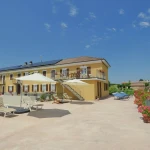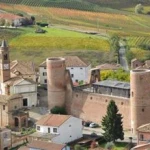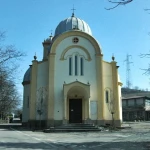You can find this route on the BikeSquare app with code A05
Pedaling up and down these Unesco heritage hills, you can savor the true beauty of Monferrato and Langhe
You will cross ancient villages and take secondary roads to touch some of the highest points in the Province of Asti.
At the end of the tour, treat yourself to a tasty aperitif based on Spumante or Barbera from our lands.
How to visit Canelli:
The track starts near the Amerio Vincenzo - Ca 'del Nono winery.
The route will take you to the small hamlet of Sant’Antonio, a small hamlet surrounded by a huge expanse of vineyards. From the church of Sant’Antonio Abate, proceed in the direction of Canelli, along a secondary road. Before starting the "descent" you could consider a detour to the famous Torre dei Contini. The Tower, dating back to 1617, delimited the boundaries of the municipality and served as a military lookout.
From here, it is possible to have a 360-degree view of the surrounding landscape, glimpsing the perfect meeting between the hills of Monferrato and Langhe.
Continuing the planned route you will arrive in the historic center of Canelli.
The town of Canelli is a small town of about ten thousand inhabitants that rises near the southernmost border of the Monferrato, a few steps from the province of Cuneo.
Canelli is historically divided into two parts: “Il Borgo” and “Villanuova”. The first, further down the valley, is the one that has continued to expand with the passing of time while the second, the oldest Canelli, lies on the slopes of the hill and is still dominated by its castle, actually Castello Gancia. The Borgo and Villanuova are connected by one of the historical elements of Canelli: La Sternia.
In the lower part of the city, down in the Borgo, from Piazza Amedeo D’Aosta you can take Via Giovanni Battista Giuliani. Continuing on this road and then turning onto Via Gioacchino Rossini, you will find yourself in Piazza San Tommaso. Here you will see the Church of San Tommaso on the left, from which the square takes its name, and further to the right the Church of the Annunziata. Between the two religious buildings begins the Sternia, a paved pedestrian street whose current name is via Villanuova.
The Sternia climbs up the hill, crosses the medieval part of the town, reaches Piazza San Leonardo, home to the church of the same name and that of San Rocco (recognizable because it is completely brick). From here the road continues uphill until it reaches the top, at the foot of what is now Castello Gancia.
The track we propose will give you the opportunity to go down this ancient part of the city.
The Castle of Canelli was the protagonist of a rather troubled history. Presumably born at the beginning of the eleventh century, the Canelli Castle originally had the purpose of defending the roads that led from Asti to Savona, essential for merchant traffic.
Subsequently the fortress has witnessed many struggles and battles that have caused repeated destruction and reconstruction, until 1929 when the Castle was purchased by the Gancia family and transformed into a large noble residence. Even today, the castle dominates the town from above and shows the Canellese and visitors its beautiful appearance of an eighteenth-century villa.
Unfortunately, as the private home of the Gancia family, the castle cannot be visited, however, at least one passage is required to admire it from the outside.
Asti Spumante is the symbol of Canelli and with it are also the places where the wine takes shape. The Underground Cathedrals are located in the Borgo and represent, in a certain sense, the buried counterpart of the town. These were recognized by UNESCO as a World Heritage Site in 2014.
We are talking about ancient and incredibly large cellars, where the fine wines of the area are brought to rest and where they develop their peculiarities. The Underground Cathedrals of Canelli belong to four great historic wineries: Bosca, Contratto, Gancia and Coppo. Although in different ways, all 4 companies make their treasures open to the public.
Always starting from Piazza Amedeo D’Aosta, take Via Giovanni Battista Giuliani: here you will meet the Contract and Bosca companies. Continuing in the direction of Corso Libertà you reach the door of the Gancia winery. The Coppo winery, on the other hand, can be found in another area of the Borgo, in via Alba.
Santo Stefano Belbo
Continuing along the track, you will cross the more modern and "industrial" part of Canelli.
A secondary road will take you to the town of Santo Stefano Belbo, making you arrive in the immediate vicinity of the birthplace of Cesare Pavese.
The famous writer Cesare Pavese, born here in 1908 and died in Turin in 1950, dedicated many of his autobiographical writings to his country of origin; the municipality transformed his birthplace into a museum dedicated to his works and youth. Pavese's remains, which remained in the monumental cemetery of Turin in the family tomb from his death until 2002, were transferred to the cemetery of his hometown in the same year.
Crossing the historic center of the town, the track climbs up a narrow hilly road until it reaches the Big Bench of Santo Stefano Belbo from which it is possible to admire a splendid view of the city below.
Continuing along the main road, the track will take you to the splendid Sanctuary of Caffi.
Cassinasco and the Sanctuary of Caffi
Tradition tells that the church was built in memory of the miracle that saw a 13-year-old young woman as protagonist, mute from birth, who saw the Madonna while she was grazing with her flock.
After the vision, the young woman would speak again.
The monument stands majestically in the midst of the surrounding wine landscape and a short stop here is definitely worth it.
Continuing, you will arrive at the town of Cassinasco.
You will find yourself in the blink of an eye in one of the highest municipalities in the province of Asti with its almost 500 meters above sea level.
From here, the route will take you around the Tower of the Old Castle, the only part that survived the sacking and fire of 1615 by the Savoy troops during the Monferrato War of Succession.
From here you will descend again towards the town of Canelli to get to cross the ancient part of San Marzano Oliveto and Moasca.
How to visit Moasca: on the way to home
In the center of the town there is the parish church dedicated to St. Peter and the Town Hall. The parish church dates back to the end of the seventeenth century and has considerable reasons of interest. To the left of the parish church, from the same period, stands the fine little church of San Rocco, in brick, with bell tower and portico, seat of the Battuti brotherhood.
The oldest part of the town, consisting of its Castle, is undoubtedly important.
The currently existing parts of the Moasca castle are what remains of the building built in 1351 as we learn from an enigmatic writing still placed today on the top of the entrance portal. The previous fortification was razed to the ground in 1308, after a long and difficult siege of which neither the origin nor the shape are known.
After a short stop / refreshment in the main square of the town, you can resume the path in the direction of the Ca 'del Nono Winery, from which you started.
Information
-
42 Km
-
4 hours 12 minutes
- Difficulty: 3







